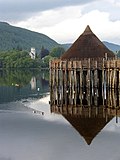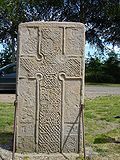Picts
The Picts were ancient Celtic people from northern and eastern Scotland.
They are first mentioned in written records in AD 297, before the Roman conquest of Britain.[1] The name 'Pict' is from the Latin pictus meaning 'painted.' This may have been due to reports from the Romans that the Picts tattoos on their bodies,[1] along with reports that ancient Celtic Britons during Roman times would paint themselves various terms that are now translated as "woad", but originally may have meant "glass" and "green" (vitrum and glastum, respectively). This process is described as staining the skin of battle wounds a dark color, since woad is a powerful astringent.[2][3] It may also refer to a name they called themselves, that was recorded by the Romans.[4]
They spoke a Pictish language. It was related to the Brythonic languages spoken by the Britons living to the south.[5] Picts were possibly the descendants of the Caledonians and other tribes that were mentioned by Roman historians.[6]
The area of Scotland called Pictland gradually merged with the Gaelic kingdom of Dál Riata.[7] This formed the kingdom of Alba, later known as Scotland. Alba then expanded, absorbing the British kingdom of Strathclyde and Bernician Lothian. By the 11th century the Pictish identity had become a part of the Scottish people.
Picts Media
The Aberlemno I roadside symbol stone, Class I Pictish stone with Pictish symbols, showing (top to bottom) the serpent, the double disc and Z-rod and the mirror and comb
Silver plaque from the Norrie's Law hoard, Fife, with double disc and Z-rod symbol
The so-called Daniel Stone, cross slab fragment found at Rosemarkie, Easter Ross
The Whitecleuch Chain, high-status Pictish silver chain, one of ten known to exist, dating from between 400 and 800 AD
The harpist on the Dupplin Cross, Scotland, c. 800 AD
Animal head from St Ninian's Isle Treasure (c.750–825 AD), found in Shetland
Pictish cross from the Monifieth Sculptured Stones, Museum of Scotland
Rodney's Stone (back-face), Brodie Castle, Forres
References
- ↑ 1.0 1.1 Paul Wagner, Pictish Warrior AD 297-841 (Oxford; Oseola, WI: Osprey Publishing, 2002), p. 4
- ↑ Van Der Veen, M.; Hall, A. R.; May, J. (1993-11-01). "Woad and the Britons Painted Blue". Oxford Journal of Archaeology. 12 (3): 367–371. doi:10.1111/j.1468-0092.1993.tb00340.x. ISSN 1468-0092.
- ↑ Pliny the Elder, The Natural History. Volume 4. BOOK XXII. Chapter 2. 78-79 A.D. "https://www.gutenberg.org/files/61113/61113-h/61113-h.htm""https://exploringcelticciv.web.unc.edu/pliny-the-elder-the-natural-history"
- ↑ Paul Wagner, Pictish Warrior AD 297-841 (Oxford; Oseola, WI: Osprey Pub., 2002), p. 5
- ↑ Paul Dunbavin, Picts and Ancient Britons: An Exploration of Pictish Origins (Long Eaton, Nottingham: Third Millennium Pub., 1998), p. vii
- ↑ Paul Dunbavin, Picts and Ancient Britons: An Exploration of Pictish Origins (Long Eaton, Nottingham: Third Millennium Pub., 1998), p. 25
- ↑ The Oxford Companion to Scottish History, ed. Michael Lynch (Oxford: Oxford University Press, 2007), p. 162










